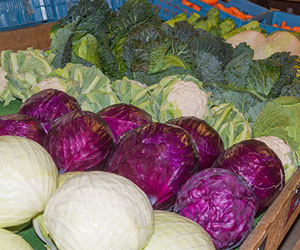
Cabbage may be a vegetable you walk right passed as you pick up a head of lettuce at your local grocery store. The round heads of different colored unpacked cabbages may even more closely resemble bowling bowls than vegetables. But, if you cut open a cabbage, you’ll find multiple layers of superimposed leaves forming what could be viewed as a giant brussels sprout. Over 100 types of cabbage can be found in nature, but typical grocery stores will have at least white, red, and savoy.
As a star member of the cruciferous family, cabbage is closely related to mustard, kale, broccoli, brussels sprouts, cauliflower, kohlrabi, and collard greens. Despite bok choy often being called “Chinese cabbage,” they are not technically in the same family. Cabbage has also been linked, at least in name, to “Tuscan cabbage” and “black cabbage,” which are Italian vegetables not commonly found in today’s food supply. Nevertheless, these linguistic links have made the history of cabbage hard to follow. Historians believe they can trace cabbage back about 2,000 years to Europe where cabbage likely grew not in head form, but more likely in leaves like kale.
Cabbage is quite an overlooked vegetable. It’s not glorified on menus like kale or shaved brussels sprouts. It’s not chosen for its beauty like roasted red beets or artichokes. It won’t make you feel fancy like asparagus or fennel. Cabbage is more like a blue collar vegetable than a white glove vegetable. It keeps for a long time in your crisper, adds easily to a variety of recipes, adapts its taste and texture to fit in, and comes in a variety of colors. It’s low in calories and rather inexpensive to boot. In fact, the USDA quantified cabbage to be the second most economic cooked vegetable in terms of price per edible cups, just behind potatoes.
People often mistake low cost for nutritionally poor. Cabbage disproves that myth as it is quite a nutritionally impressive cruciferous vegetable. One cup of raw cabbage provides less than 40 calories, but also has significant amounts of vitamin C, vitamin K, and folate. Where cabbage really stands out is its antioxidant levels. 20 different flavonoids and 15 different phenol compounds have been identified in cabbage. These are what give cabbage its antioxidant, anti-inflammatory, and anti-cancer benefits. In addition, cabbage is also associated with cardiovascular benefits, digestive health benefits, and has been linked to reduced risk of type 2 diabetes.
For gastric sleeve, gastric bypass, and lap band patients, cabbage ticks a lot of boxes: low in calories, low in carbohydrates, good source of fiber, tastes good, easy to find and easy to cook, and provides nutritional benefits. Cabbage can be filling without using up all your calories, which can help promote weight loss in bariatric patients as well as anyone trying to lose weight. It makes a great side dish while adding very few carbohydrates. As obesity is thought to contribute to inflammation in the body, the anti inflammatory compounds in cabbage can be especially important for obese and overweight individuals.
Because of cabbage’s nutritional benefits, low calorie content, low cost, familiarity, and general abundance, we will be sharing a series of recipes that incorporate cabbage to highlight its versatility and flavor.
The above Food Highlight is offered by Dr. Shillingford, M.D., P.A., a board certified surgeon specializing in advanced laparoscopic and bariatric surgery. Dr. Shillingford’s gastric sleeve, lap band, and gastric bypass patients come to his Boca Raton office from both South Florida and Northern Florida, as well as Georgia, Texas, Ohio, New York, New Jersey, and Michigan. His weight loss surgery patients are often looking to explore new and different foods, and while cabbage is anything but new, it can be incorporated into dishes that fit nicely into a post bariatric surgery diet as it packs a lot of nutrition into 40 calories per cup.

 Am I A Candidate
Am I A Candidate  BMI Calculator
BMI Calculator  Why Choose Us
Why Choose Us